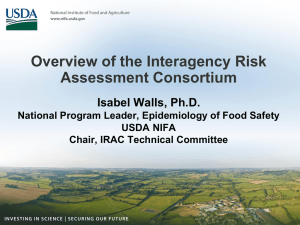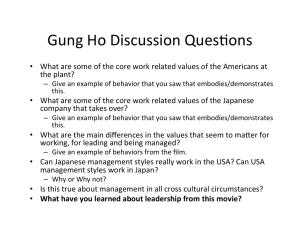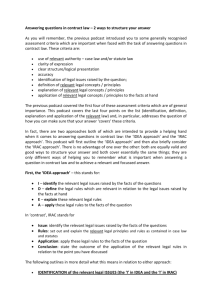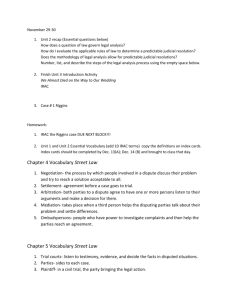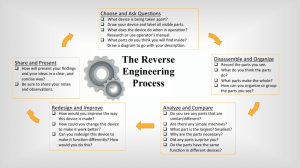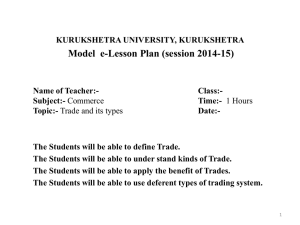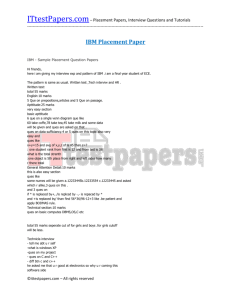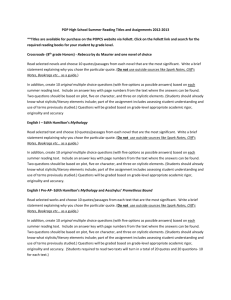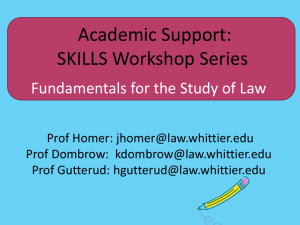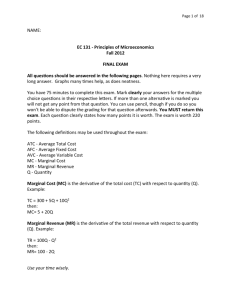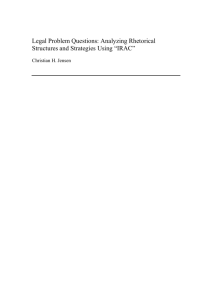IRAC ORGANIZATION
advertisement
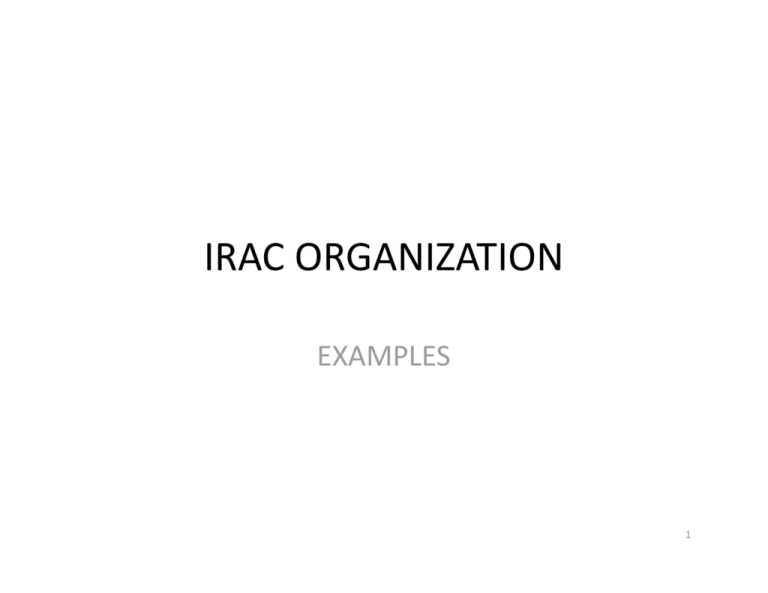
IRAC ORGANIZATION EXAMPLES 1 IRAC • IRAC (Issue, Rule, Analysis, and Conclusion) forms the fundamental building blocks of legal analysis. It is the process by which all lawyers think about any legal problem. The beauty of IRAC is that it allows you to reduce the complexiLes of the law to a simple equaLon. • ISSUE‐> What facts and circumstances brought these parLes to court? • RULE‐> What is the governing law for the issue? • ANALYSIS‐> Does the rule apply to these unique facts? • CONCLUSION‐> How does the court's holding modify the rule of law? 2 ISSUE SPOTTING: STEP ONE • "The facts of a case suggest an Issue." • The key to issue spoXng is being able to idenLfy which facts raise which issues. Because of the complexity of the law, the eliminaLon or addiLon of one fact (such as Lme of day or whether someone was drinking) can eliminate or add issues to a case thereby raising an enLrely different rule of law. • In law school casebooks, the easiest way to isolate the issue is to merely look at the chapter headings of the cases, such as "Personal JurisdicLon" in Civil Procedure or "Offer and Acceptance" in Contracts. The cases you read will also contain language that signals the important issue. For instance, the judge will simply state: • "The case turns upon the ques?on whether...." OR "We come then to the basic issue in the case." 3 ISSUE SPOTTING CON’T • Ques)ons to ask when reading a case: • What facts and circumstances brought these parLes to court? • Are there buzzwords in the facts that suggest an issue? • Is the court deciding a ques?on of fact ‐ i.e. the parLes are in dispute over what happened ‐ or is it a ques?on of law ‐ i.e. the court is unsure which rule to apply to these facts? • What are the non‐issues? 4 RULE • Rule ‐ What is the Law? • "The issue is covered by a Rule of law." • Simply put, the rule is the law. The rule could be common law that was developed by the courts or a law that was passed by the legislature. 5 RULE CON’T Ques)ons to ask when reading a case: What are the elements that prove the rule? What are the excep?ons to the rule? From what authority does it come? Common law, statute, new rule? • What's the underlying public policy behind the rule? • Are there social considera?ons? • • • • 6 ANALYSIS‐THE ART OF LAWYERING • "Compare the facts to the rule to form the Analysis." • This important area is really relaLvely simple. For every relevant fact, you need to ask whether the fact helps to prove or disprove the rule. If a rule requires that a certain circumstance is present in order for the rule to apply, then the absence of that circumstance helps you reach the conclusion that the rule does not apply. For instance, all contracts for the sale of goods over $500 have to be in wriLng. Consequently, in analyzing a contract for the sale of goods, you apply the presence or absence of two facts ‐ worth of good and whether there's a wriien contract ‐ in order to see whether the rule holds true. 7 Analysis Con’t • Ques)ons to ask when reading a case: • Which facts help prove which elements of the rule? • Why are certain facts relevant? • How do these facts saLsfy this rule? • What types of facts are applied to the rule? • How do these facts further the public policy underlying this rule? • What's the counter‐argument for another soluLon? 8 CONCLUSION – TAKING A POSITION • "From the analysis you come to a Conclusion as to whether the rule applies to the facts." • The conclusion is the shortest part of the equaLon. It can be a simple "yes" or "no" as to whether the rule applies to a set of facts. A professor will onen give you a set of facts that could go either way in order to see how well you analyze a difficult issue. The mistake many students make is to never take a posiLon one way or the other on an issue. Most professors want you to take a posiLon and support it in order to see how well you analyze. 9 CONCLUSION – TAKING A POSITION Ques)ons to ask when reading a case: What's the holding of the case? Has the holding modified the exis?ng rule of law? What is the procedural effect of the holding? Is the case overturned, upheld or remanded for retrial? • Does the holding further the underlying policy of the rule? • Do you agree with the outcome of the case? • • • • 10 IRAC TRIAD • IRAC is a good model. However, in the pressure of the exam, many students leave out the most important part of the equaLon ‐ the analysis. In order to illustrate the important of the analysis, I've modified the tradiLonal model into what I call the IRAC Triad. • 11 IRAC TRIAD CON’T • The IRAC Triad emphasizes the Analysis by using the Facts, Issue and Rule as building blocks. The Analysis is the end product and primary goal of the IRAC Triad, but the role that facts play in forming the analysis is highlighted. • Step 1: The facts of a case suggest an Issue. • The legal issue would not exist unless some event occurred. • Step 2: The issue is governed by a Rule of law. • The issue mechanically determines what rule is applied. • Step 3: Compare the facts to the rule to form the Analysis. • Do the facts saLsfy the requirements of the rule? • The Triad is actually just a simple flowchart in which the facts can be pigeonholed into a Conclusion. 12 Contracts HypotheLcal: FACTS • Facts: • An old man who is very ill and near death makes an oral contract with his nephew. The terms of the contract are that the uncle will immediately give his nephew all of his life savings ‐ $100,000 ‐ in return for the nephew's promise to provide food and shelter for the old man unLl the man dies. The nephew takes the money and supports the old man at a cost of $10,000 a year. The old man lives longer than expected and is sLll alive aner fineen years, at which point the nephew cuts the old man off without further support. 13 ISSUE? 14 Issue Is an oral contract valid after fifteen years? Note that the issue is stated in the form of a question and uses key facts to illustrate the problem. Don't be alarmed if you didn't see the issue right away. By reading case law in contracts, you will learn that these sorts of factual situations give rise to issues surrounding whether a contract is valid. 15 RULE? 16 Rule A contract must be in writing if it is not possible to perform the contract within one year. - Statute of Frauds The issue immediately triggers the appropriate rule. Again, the appropriate rules are something that you will learn in your first year of contract law. 17 ANALYSIS? 18 Analysis The Statute of Frauds does not state that the contract must be performed within one year. It only states that it must be possible to complete the contract within a year. Since a very ill, old man could have died within one year, it is possible that the contract could have been completed. This analysis shows how closely you must pay attention to the wording of a rule. The words "not possible" indicate that a remote possibility of being able to complete the contract means the rule does not apply. 19 CONCLUSION? 20 Conclusion • The Statute of Frauds probably does not apply in these circumstances, and the oral contract is not invalid even though it was not completed within one year. • Conclusions should be short and put in terms of a probability. 21 Civil Procedure Hypothe)cal Facts: • 1. Patricia sues Daniel in federal district court over money that she says he owes her. • 2. She wins her case. • 3. Daniel appeals the decision in the federal appellate court, which overturns the lower court's decision on a technical error. • 4. Patricia appeals to the U.S. Supreme Court, and the court refuses to hear the case. • 5. Patricia aiempts to sue Daniel a second Lme in the state court system over the same issue of the money she says he owes her. 22 ISSUE? 23 Issue • Does the fact that Patricia took her case to the highest federal court and lost prevent her from starLng the same case in a state court? • Civil Procedure ques?ons quite naturally focus on whether a plain?ff or defendant has correctly followed the rules in bringing a case to court. Civil Procedure generally does not focus on the substance of the dispute ‐ i.e. whether the plain?ff or defendant wins. 24 RULE? 25 Rule • The principle of res judicata states that once a final judgment on the merits has been made on a parLcular case, the plainLff is barred from bringing that same case against the same defendant in the same or different court. 26 ANALYSIS? 27 Analysis • Since Patricia appealed the case to the highest court, a final judgment is considered to have been made on the maier. She has exhausted all of the potenLal appeals by going to the highest court which has ruled on her case. If she aiempts to bring the same cause of acLon (i.e. the same parLcular facts and controversy) in state court, then Daniel can argue to have the case thrown out of court using the principle of res judicata. 28 CONCLUSION? 29 Conclusion • Patricia cannot bring the case in state court. 30

